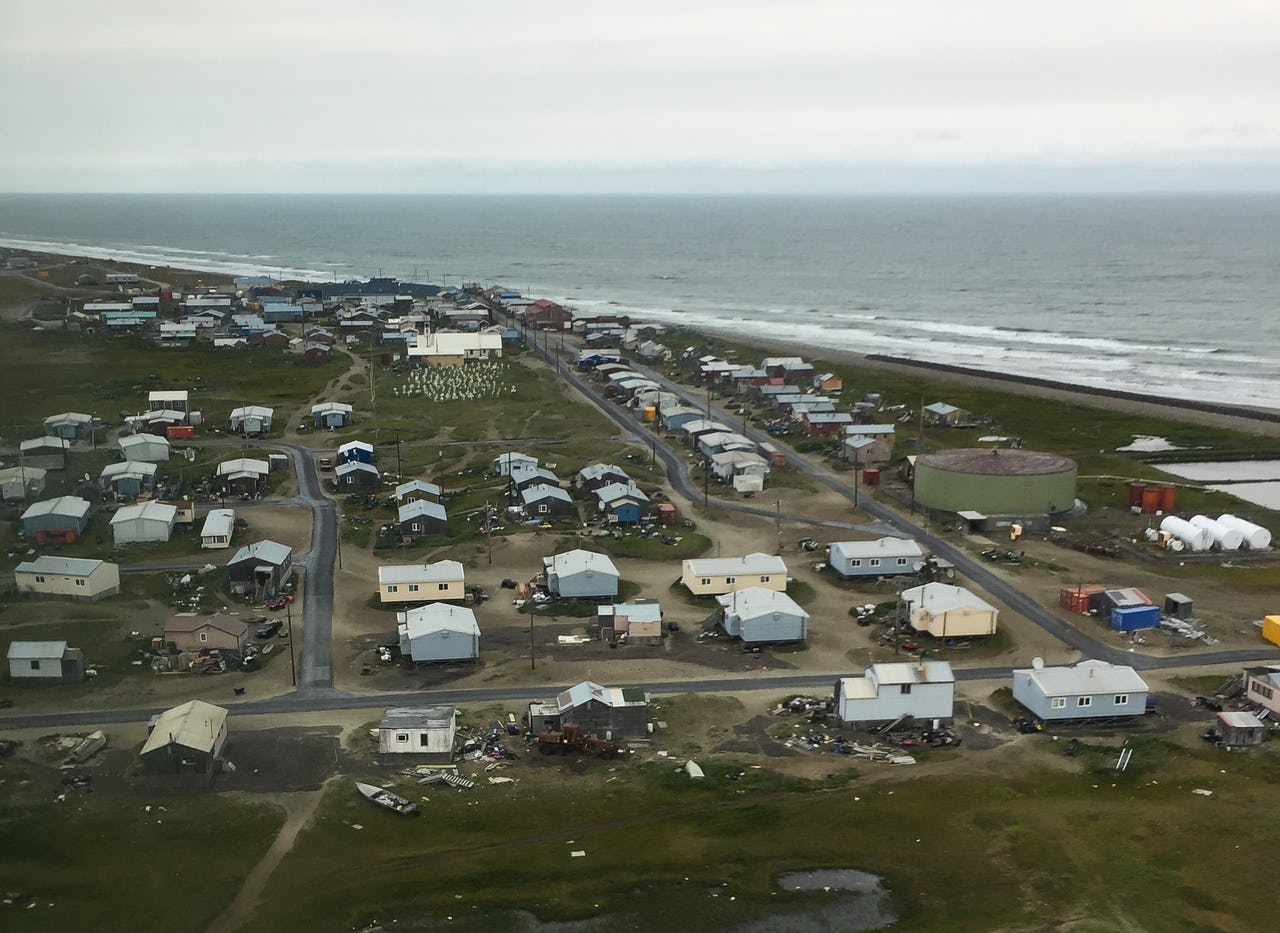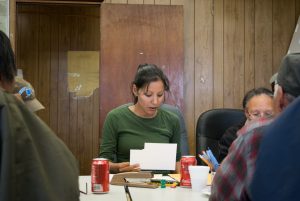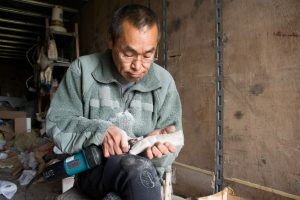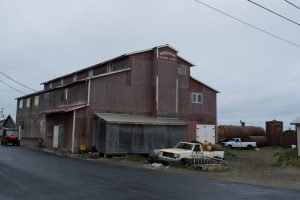Self-Preservation: Amid Debate, An Alaskan Village Decides to Move Inland

The native village of Shishmaref, viewed from the northeast side of Sarichef Island. Photo: Eli Keene
As part of The Arctic Institute’s Summer Reading Series, we are reposting 10 stories from Managing Director Victoria Herrmann’s National Geographic-funded project, America’s Eroding Edges.
The edges of our country are eroding, raising difficult questions about adaptation, relocation, and what it means to be an American experiencing climate change today. To connect the shared experiences of Americans facing these dramatic transformations, the National Trust for Historic Preservation has partnered with Victoria as she travels around the U.S. and its territories interviewing communities directly affected by shoreline erosion and climate change.
The Arctic Institute Summer Readings 2017
- A Continual State of Emergency: Climate Change and Native Lands in Northwest Alaska
- Self-Preservation: Amid Debate, An Alaskan Village Decides to Move Inland
- When the Sea Wall Breaks: Climate Change in Teller, Alaska
- Fighting the Rising Tide in Shaktoolik, Alaska
- Climate Change Hope in America
- A Delicate Balance of Commerce and Climate Change in Nome, Alaska
- Frontier of Change
“It was a crazy day,” sighs Tiffany Magby, acting clerk of the Shishmaref City Council. It is mid-August and Tiffany has just emerged from a meeting certifying the results of a village referendum. By a vote of 94 to 78, the community elected to relocate in full from its current site onto the Alaskan mainland five miles away.
Shishmaref sits on a narrow barrier island in the Chukchi Sea. At points, the island measures barely a quarter mile wide. For hundreds of years, Shishmaref has been losing land to the sea from natural erosion trends. But with climate change, that natural trend is getting a lot worse.

Here in Alaska, global warming is happening twice as fast as anywhere else on earth. And all that heat is melting ice and thawing permafrost, or frozen ground, at an unprecedented pace. In normal years in Shishmaref, an icepack usually develops in the fall months around the island. This ice has always acted as a buffer against severe storm surges, forcing waves to break miles off shore instead of against the village. But as the ice disappears, so too does this natural defense.
No ice, combined with the effects of thawing permafrost—the softening of the very land the village is built upon—has resulted in a loss of three to five feet of shoreline per year, with a single severe storm washing away 50 feet of land. Storms caused such severe erosion in 1997 and 2002 that some homes actually fell into the ocean and several more needed to be moved.
While Shishmaref has recently erected a new sea wall, many believe that relocating is the only way to keep the community safe.
“We did have some fresh 18-year-olds come in to register to vote,” says Tiffany. “They had some very good opinions about relocating. They were so for it, because the new generation and their kids are going to be the ones … [around] when the time comes for us to do an emergency evacuation.”
But as the close vote might suggest, Shishmaref is of two minds about relocating. Part of that divide is born from the question of where the money to relocate will come from; moving the village to a new site will cost about $180 million.
Cliff Weyiouanna is one of those who voted to stay. At 74, Cliff has witnessed a lot of talk about relocation, including an effort by the community to relocate in 2002, which was later abandoned due to lack of funding.
“When people asked how did I vote, I say, ‘I know we’re not going to get funding from the state or government so I voted to stay,’” he tells us. We are among dozens of researchers and journalists that Cliff has invited to his breakfast table to talk about the impacts of climate change in Shishmaref. He keeps a sizeable guestbook tucked away to track just how many visitors he’s served sourdough pancakes to over the years. But even with its international media coverage, the money has not yet come forward.

“I don’t know [if they’ll find funding],” he says. “It’s gonna take a long time. They have to go back and test the soil. Last time they had someone from the government drill test every mile. There was three feet of soil and two feet of ice there, so that wasn’t stable. Now they have to work on building the road. It ain’t going to be easy.”
Cliff also notes a less visible problem with voting to relocate—one that was on the minds of many elders in the community: “Whenever a village votes to relocate like us, all the federal money for new clinics and programs comes to a halt.”
Fred Eningowuk, another elder, has seen this happen with his own eyes.
“The word relocation—it’s hindering our community,” he tells us. “I attended several meetings and one funding agency wanted to recommend not to fund replacing our tank farms,” he continued, referring to the large metal containers used to store fuel for the remote community. “And I told them that even if our community decides to relocate or stay in place, we are in dire need of a tank farm for our community. I am very afraid—those tanks are disasters waiting to happen. I’m afraid I can hit those with a rigid object and cause a major oil spill, gas spill, a disaster within our community.”
Advocating for infrastructure to support a community that intends to leave is a tough needle to thread. This is particularly true in the remote communities of rural Alaska, where building anything is expensive and most supplies must be flown in. But it is equally unrealistic to expect communities like Shishmaref to live without essentials—whether it be the sea wall, the tank farm, or even running water, which most of the village lacks—until some unknown date when the village might be moved.
Back in the City Council office, Tiffany demonstrates how even small losses of community resources can have major impacts on the community. “Right now, I think our biggest issue besides the [vote] is our Laundromat,” she says. “We have one washer available for the whole island—about 600 to 700 people.” Replacing a broken washer is expensive, requiring a special order to Nome and then shipment by air to the village. It is also a striking reminder that a vote to move does not erase the daily needs of a community.

The problem with the Laundromat is also reflective of a deeper issue for Shishmaref. On the other side of the rusting tank farm is the Nayokpuk General Store, one of two groceries in Shishmaref. Inside, owner Percy Nayokpuk laments the general state of the village economy over the past decades. In Percy’s view, everything changed in 1971 when Congress passed the Marine Mammal Protection Act, which banned the sale of marine mammal products such as pelts, except those in the form of native handicrafts.
“The biggest change,” Percy says, “is trying to survive without an economy. It’s very tricky. Back in the day the hunters here all made more than the sole white man in town, who was a teacher. The economy was taken away in 1971. And no alternative was given. Now it’s all transfer payments from the government. We were once very independent. Now we’re dependent.”
Peeling back the many layers of funding problems, an image comes into focus that extends far beyond the growing threat of erosion and climate change. Shishmaref is not only facing an environmental crisis—they are facing that environmental crisis at a time when their local adaptive capacity has been severely damaged from decades of political and economic disenfranchisement.
But the potential to solve this problem exists in the village. In addition to being expert hunters, many Shishmaref residents are expert carvers whose carvings sell for hundreds of dollars through middlemen in Nome. A tannery at the top of the island allows production of traditional goods, though it faces high energy operating costs and has fallen into disrepair.
Reconstructing an economy in such a remote place is no easy task. It means looking beyond physical relocation costs to investing in Shishmaref as a community—in its historic livelihoods, its immediate needs, and its vision for the future.
The commentary was originally published on December 5, 2016.